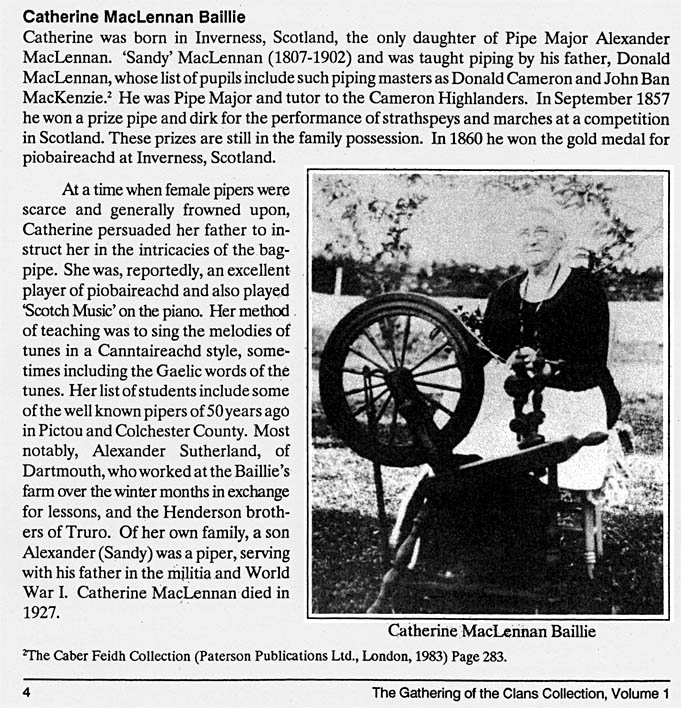History in the making...Historical Piperchicks
My hope for this page is that it will undergo constant growth as people (myself strongly included) locate more information on piperchicks of the past. However, this is slow going. So to tide you over until I get some real information on here, here are the meager findings I have so far unearthed. (Please help! If you have info on a historical piperchick, please contact your charming hostess: tesser@piperchicks.com. Thank you!)
I found a great book in the UC Berkeley music library with several references to historical female pipers in it. It's called The Highland Pipe and Scottish Society 1750-1950, written by William Donaldson, copyright 2000, Tuckwell Press Ltd. All of the following information comes from this book, and page numbers that are not otherwise referenced refer to it.
In reference to female players of the eighteenth century, Donaldson notes that "Women played as well, sometimes to a high standard, although it seems not to have been considered appropriate for them to do so publicly." (p. 177)
Early Piperchicks: The MacCrimmon Women
Donaldson notes that the women of the MacCrimmon family are often mentioned in some sources, and he speculates that this may be in order to point up the excellence of the family's piping abilities overall (see, even our women are master players)(p. 157). Alexander MacGregor is quoted as saying "Padruig Mor [MacCruimean] had a daughter who was very expert at noting, and could also play herself when asked as a favor to do so." (p. 139, originally from Celtic Magazine, vol. 5, 1880, p. 483-484). Donaldson mentions MacCrimmon's daughters playing in the Pigeon's Cave at the MacCrimmon's "college" at Boreraig, and quotes from MacKay that they were "able in his absence to superintend the instruction of the students". (p. 156-157, originally from Angus MacKay,"A Collection of Ancient Piobaireachd or Highland Pipe Music", 'Account of the Hereditary Pipers', p.8)
Elizabeth MacCrimmon
Donaldson has a great story about Elizabeth MacCrimmon (p. 212) that I will put up here as a direct quote, because the original language is so good. The quote originally came from John Johnston, from the Oban Times, 9-12-1896.
"Duncan Rankin, of the Mull pipers, went to study a while with 'Donald Ruadh McCrimmon'; another pupil from Morar happened to be there also, and both appear to have been smitten by the charms of McCrimmon's daughter, named Bess, or likely Elizabeth. The Morar swain, when well learned, went home to his own country, but suddenly returned with a friend to bring matters to a point. The lady understood their errand at once, and slipped to the other end of the house, took up her father's bagpipes, and played 'Sann a bha 'n t-sheotrich air Bodich na Morthir', [there was naught but sloth amongst the carles of Morar] a tune well known to the young man, and at once understood, with its import on that occasion, and thinking it was MacCrimmon himself who played it as a broad hint, he told his companion that their errand was useless, and immediately departed without saying a word about their business. Rankin married her shortly thereafter, and came to the island of Muck, where he was piper to that family for a long time, and when the family removed to Coll, he came there with them, and was there the remainder of his days - both of them are buried in Killinaig, in that island. She could play the pipes as well as her father's pupils, and on one occasion in Grisipool House, Coll, during her husband's temporary illness, played in the passage during dinner, and none of the gentlemen present distinguished any difference, though her husband was one of the greatest pipers in the Highlands in his time, having come through both the great seminaries in Mull and Skye, with the highest proficiency...When her husband, who was rather quick tempered, found fault with his pupils about their playing of particularly difficult portions of tunes, would abruptly retire and leave off his tuition in anger, she would take her distaff, and lift the necessary fingers on it, showing them to perfection where they lacked."
The Teaching Connection
Apparently, it was not too uncommon for women to teach the bagpipes in earlier eras. Donaldson states "There is little direct evidence about the teaching process before the end of the 19th century, but it appears that women were quite frequently involved." (p. 211). He says that John Ban MacKenzie (who learned from Mackay) had some part of his teaching from a woman: "Mackay used to turn his back on the pupils, and play the tunes. Mackay's sister used to sit by the fire, and dictate the words of Canntaireachd, and sing them as the piper played." (p. 212-213, originally quoted from John Ban MacKenzie's pupil Duncan Ross, in J.F. Campbell's "Canntaireachd: Articulate Music", Glasgow, 1880)
(Note: this bit on Catherine Baillie comes from The Gathering of the Clans Collection, Vol. 1, not the Donaldson book)

Go back to the main page
